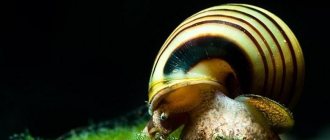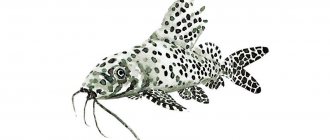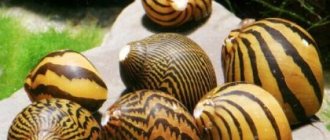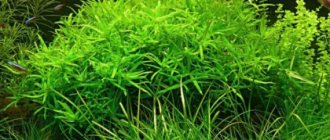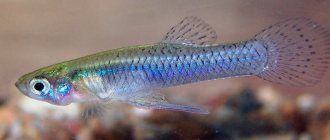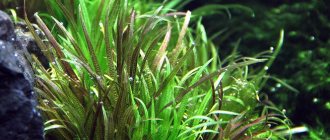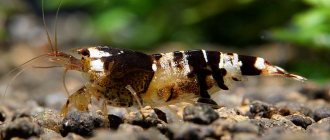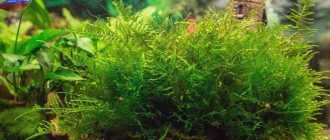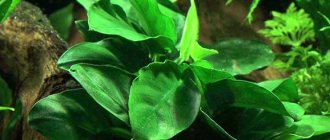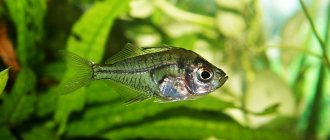Description and distribution of rotala
The forms cultivated in aquariums are herbaceous perennials, growing up to 35 cm in height. Their stems are thin, long, and knotty. From each node, oblong petioleless leaves are formed. Old leaves, shaded by the apical ones, die off, and the lower part of the stem becomes bare. The color of the plant varies from soft green to reddish purple.
The root system is weak, represented by a creeping rhizome with thread-like roots. Additional root shoots appear on the stems. They are not fixed in the ground, but are freely located in the water column.
Above-water shoots may bloom. Flowers of regular shape, solitary or collected in apical inflorescences. They form dry fruit boxes filled with small seeds.
The natural habitat of the rotala is tropical and temperate latitudes. It grows on river shallows and wetlands. Some species are common in southeast Asia, Georgia, Armenia, Azerbaijan and other Transcaucasian countries.
Reproduction and planting
Rotala is propagated by cuttings. To do this, you need to cut off part of the stem (no more than 7-10 cm) and plant it in nutritious soil. After a few days, the cutting will adapt to the new conditions and take root. It is important at this time to maintain the temperature within 27-30 degrees and provide the plant with bright lighting. If the cuttings are planted in a greenhouse, it is necessary to maintain high ambient humidity.
It is worth noting some rules that must be followed when replanting a plant:
- Rotala is sensitive to touch. She does not tolerate frequent touching with fingers, so it is better to work with special tweezers, gently squeezing the plant;
- If it is transplanted or propagated in aquarium conditions, it is important to prevent the rhizome from coming into contact with air;
- Rotala is afraid of blue-green algae thickets. They cover the leaves, depriving them of vital light.
Useful video: How to trim Indian Rotala
Benefits for the aquarium
This is a graceful, actively growing herb. It looks impressive as a plant on its own, emphasizing the structural depth of the background of the aqua zone, and can be used to create aesthetically attractive underwater compositions.
Rotala affects the hydrochemical characteristics of the aquatic environment:
- absorbs nitrogenous and other compounds;
- saturates water with oxygen;
- becomes a haven for bacterial flora, which is a natural aquarium filter.
It creates favorable conditions for the life of fish and other inhabitants of the artificial biocenosis. Fry and adults can hide in the thickets; the foliage serves as an additional source of food for some of them.
Indica Rotala - jackpot for the aquarium
Indica is valued not only for its exotic hydrophyte, but also for its ability to maintain the biological balance of the biosystem environment. In the Rotala aquarium, Indian serves as a kind of filter, participating in metabolic processes:
- absorbs carbon dioxide;
- produces oxygen;
- neutralizes excess nitrates and phosphates.
The grass is considered a “litmus test”, reacting with the color of its leaves to any changes in water balance.
11:27
Signs of a lack of Microelements in the Aquarium. Clearly! Filamentum on Moss Xenococus on Anubias
07:16
Aquarium plants. Rotala macrandra and fertilizer dosages for it.
06:49
Overdose of microfertilizers in the aquarium. Incorrect pruning of plants.
Fish like to eat rotala indica. It is better not to use it with those digging the bottom, because, raised from the bottom, the suspension will destroy the plant.
Types of aquarium rotala
The genus Rotala includes many hygrophytic plants. They differ in the color of flowers, leaves and other features.
Rotala Walliha
The species R. wallichii, although demanding regarding conditions in the aquarium, is attractive for its decorative effect. Its thin, erect shoots up to 35 cm high give almost no lateral branches. They are densely covered with needle-shaped leaves about 15 mm long, the color of which varies from pale green to crimson. Sometimes it is possible to achieve a particularly spectacular golden-pink hue.
Rotala Wallich.
Indian
Rotala indica is found naturally in India, China, and Indonesia. Its reddish lanceolate leaves, which take on a bluish tint in bright light, are distinguished by their opposite arrangement. Their width does not exceed 3 mm. With photodeficiency, the stems become elongated, the leaves become smaller and pale, the plant loses its attractiveness, becoming a banal representative of the aquarium flora.
Round-leaved
This type of plant is often identified with rotala indica, believing that this is its terrestrial form. The plants are similar in many ways, but represent different taxonomic groups. The round-leaved variety (R. rotundifolia sp. green) is distinguished by a slightly larger distance between the stem nodes. Its oval leaves, about 12 mm long, are colored rich green. Red flowers may appear on the surface of the stems. If you pinch the top, the shoots will begin to actively branch, creating picturesque thickets.
Nanyenshan
Similar to Rotala Wallich. Its long (up to 2.5 cm) narrow leaves are collected in several pieces in closely spaced whorls. In good light, the stems are located horizontally, almost parallel to the ground surface, and the apical foliage acquires an amber or golden-red hue. With an inclined orientation, the shoot plant can be placed in the central part of the aquarium.
Macrandra
Large-stamen rotala (R. macrandra) is characterized by increased sensitivity to changes in housing conditions. The arrangement of the leaves is opposite, the color ranges from pinkish-olive to deep red. The flowers are pink with long stamens rising above the receptacle.
Macrandra.
There are several subspecies of makrandra:
- Red. The largest-leaved of the rotals. The leaves are oval, up to 3 cm in length.
- Green. Less whimsical. The leaf blades are smaller, soft green on the upper side and pinkish on the lower side.
- Narrow-leaved. Differs from green in smaller width of foliage (up to 10 mm). Branches well.
- Tiger. Characterized by pronounced venation of leaves. The color is red or pinkish, the veins are lighter.
- Mini. The stem is 10-15 cm long, covered with small elongated leaves.
Several hybrids have also been developed.
Hipuris
R. hippuris grows in Japan and is found in decorative ponds in Taiwan. Coastal specimens rise above the ground by half a meter. The stem is whorled, the leaves are needle-shaped, light green or golden in color. The nodes and apical part may acquire a light or rich pink tint. Plants are planted in a cluster, most often in the background and on the sides.
Perls
Pearls (Rotala pearls) grow in the wetlands of Singapore, but are rarely found in aquariums. The leaves are small, 5-7 mm, curved, juicy green on top, pinkish or violet on the reverse side. The lateral edges curl towards each other at an angle, giving the leaves a pointed shape. The species is not characterized by rapid growth, and with insufficient care it becomes similar to the round-leaved variety.
Pusila
Rotala pusilla grows in Japan, Brazil, and African countries. The stem is dense, tall (up to 40 cm), erect. The leaves are narrow, pointed, the ends are slightly curved downwards. There is a pronounced resemblance to indica, but the color of the foliage is predominantly yellowish, the stem is red or light brown. For rapid growth, good care is needed.
Rotala Pusila.
Bangladesh
The variety is widespread in the waters of Bangladesh, as reflected in the name. She is relatively unpretentious. Used for planting in the middle ground against a background of aquarium greens.
The stems of this hygrophyte are densely leafy, about 20 cm high. The leaf blades are thin, 1-1.5 mm wide, mostly light green. Bright lighting promotes pinking of shoots and apical leaves.
Butterfly
Rotala sp. Butterfly is a compact plant of bright crimson or red color, often considered as a form of makrandra. It got its name because the leaves resemble butterfly wings. They are thin, wavy, shiny, oval in shape with a pointed edge. They are located in nodes in pairs opposite each other. The average height of the shoots is 15 cm, so they can be placed in the foreground.
Mexican goias
Distributed in tropical and warm temperate regions throughout the world. It is a weed of rice plantations. The stem of this variety is creeping or erect and branches well. The leaves are reddish-green, narrowly lanceolate, in the above-water environment they become wider (up to 5 mm), in whorls of 3-5 pieces. The flowers are solitary, formed in the leaf axils.
Mexican goyas.
Features of rotala content
For active growth and preservation of decorative features, special conditions must be created.
Requirements for an aquarium
Preference should be given to containers with a volume of 100 liters or more. Aeration and filtration equipment should be located away from them.
The water should be soft (5-10°F), fresh and unturbid, acidity should be low or neutral. The temperature is maintained at +24…+28°С. When it decreases, growth slows down; further decrease leads to the death of the plant. Change 15-25% of the water volume weekly. Carbon dioxide supply required.
Intense lighting is required, the brightness of which is selected individually. In dim light it becomes very stretched and loses color saturation. Its excess can lead to the appearance of algae, which will cause the sprouts to die. Light mode – at least 10 hours of backlight in addition to 2 hours of natural light.
Priming
The composition of the soil is not particularly important; natural siltation is enough for nutrition. The grass develops well in a floating state (without rooting). Although the roots are weakly anchored in the soil, rooted specimens grow faster and look more impressive.
The substrate should not be too dense. You can use coarse sand or pebbles with the addition of peat. Layer thickness – 3 cm.
Landing
The prepared cuttings are placed in aquarium water and left for several days. When the roots are 0.5 cm long, the sprouts can be planted. They are placed in groups of 10-20 copies, placing clay lumps under the roots. Select the most illuminated areas with minimal flow, mainly in the background and on the sides. For better fixation in the sand, the roots are pressed with gravel.
Difficulty in content
Sometimes the advantages turn into disadvantages: the fast-growing rotala needs quite frequent thinning to provide sufficient living space for other inhabitants of the aquarium. Fortunately, this is not difficult to do - the stems are easily pulled out of the ground.
In addition, from time to time experts advise replacing old plants with new shoots, since the “stems” become bare quite quickly. The replacement is done like this: the plant is pulled out, and its lush top (about 5 centimeters long) is torn off and planted in the vacant space. Roots should appear in the soil very soon.
One of the main difficulties is the need for additional lighting. If you ignore this point, you can lose the main thing - the leaves of plants will never acquire a red or golden color, and this is one of the most remarkable qualities.
Keeping in an aquarium
The volume of the aquarium for the best growth of rotala is 120 liters.
The soil is neutral, nutritious. It is good if, in addition to fine gravel, clay and peat are added in small quantities. The sludge won’t do any harm either, as it will become an additional source of nutrition for the plants. It is important that there is not too much of it. The total thickness of the soil is three centimeters.
The plant does not need additional feeding or fertilizer.
The water temperature should not fall below 24 degrees. Water can be neutral or slightly acidic, but not alkaline. It also should not be cloudy - this inhibits the growth of the plant. During “general cleaning”, a fourth or fifth of the aquarium’s water volume is usually changed.
Plant cuttings prepared for planting do not have to be immediately planted in the ground. If you send them “free swimming” on the surface of your small pond, they will have time to acclimatize and even sprout roots. After this, rooting in the ground will be more successful.
The plant requires artificial lighting: you can combine fluorescent lighting with a regular incandescent lamp. The duration of the artificial day should be half a day, in addition to the natural two to three solar hours per day.
Compatibility with other aquarium inhabitants
In the plant aquarium world, the Indian rotala has no offenders. Rather, she herself can infringe on the rights of someone, energetically developing the territory. Experts consider large-leaved plants to be the best neighbors, based on purely decorative considerations.
Among the representatives of the aquatic fauna rotala, you should be wary of voracious fish, which eagerly feast on delicate leaves. Among the "gluttons":
- guppy,
- swordtails,
- angelfish,
- catfish,
- hummingbird fish,
- Molly,
- goldfish.
To avoid troubles, it is advisable to “green” an uninhabited aquarium, and only then the Indian rotala, which has gained strength, will not allow itself to be offended. In addition, there are special food for fish, rich in plant elements, which completely compensate the fish for the need for “pasture”.
Diseases, their treatment and prevention
Indian rotala is practically not susceptible to any diseases. And yet, ailments do occur and are associated either with water, if it does not provide the microelements necessary for the plant, or with poor-quality soil. A diseased plant will immediately make itself known: it changes its natural color and withers. All rotten parts of the plant must be removed quickly (you can use tweezers) so that the unpleasant process does not spread to healthy neighbors.
Experts consider the most critical moment to plant a newly acquired specimen. From the greenhouse conditions of the nursery, the plant finds itself in an unusual environment and experiences stress. If it fails to adapt, it dies. That is why it is very important, at least at first, to create for the plant the conditions to which it is accustomed.
Lifespan
Rotala is a type of plant that does not know what the change of seasons is; it does not have a so-called dormant period, like other representatives of underwater flora. With proper care, it seems that this plant is eternal. What is it afraid of that could end its life:
- careless touching of fingers;
- exposure of the root system to atmospheric air (for example, during transplantation);
- presence of blue-green algae in the aquarium.
Average price and where to buy
Many aquarists note the availability of Indian rotala - low prices and many offers on various Internet sites.
You can purchase plants in a pot. For ten pieces you will have to pay 435 rubles (https://www.aquariumhome.ru). You can - in a bunch, for 70 rubles in an online pet store, or in a bunch with a weight - for 170 (https://www.zoo71.ru).
